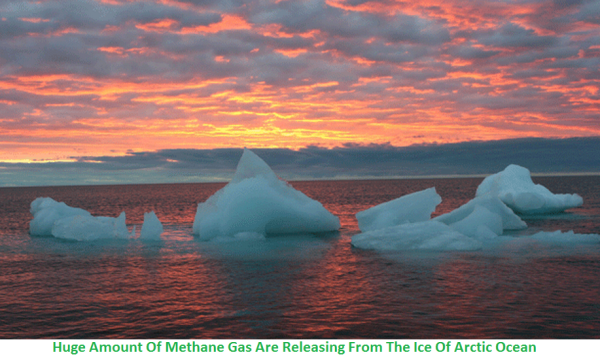NASA scientists have detected a highly potent greenhouse gas, Methane, is being released in large volume from the crumbling Arctic Ocean ice. If the massive volume of methane gas releases into the atmosphere from the cold waters beneath, then this could create bad effects on the climate. In fact, it’s a catalyst for global warming.
The Arctic region is one of the many natural sources of methane gas. There are billions of tonnes of methane gas in permafrost. A high volume of methane release would greatly affect the climate. No doubt, it would accelerate the global warming. This high volume of methane gas has been found in icy crystals beneath the Arctic sea.
A Gulfstream V aircraft was flown over the Pacific Ocean from the North Pole to the South Pole. It collected atmospheric measurements from the ground to an altitude of 8.7 miles (14 kilometers). During 2009 to 2010, when 5 flights went over the Arctic Ocean, venturing to latitudes of up to 82 degrees north, researchers found increased methane levels at low altitudes over the remote Arctic Ocean, north of the Chukchi and Beaufort Seas which was about one-half percent larger than normal background levels. There was no carbon monoxide in the atmosphere. Researchers thought, the methane gas was coming from high-latitude wetlands.
“While the methane levels we detected weren’t particularly large, the potential source region, the Arctic Ocean, is vast, so our finding could represent a noticeable new global source of methane,” says Eric Kort of the Keck Institute of Space Studies at Caltech.
By comparing locations of the enhanced methane levels with airborne measurements of carbon monoxide, water vapor and ozone, researchers pinpointed the ocean surface as the source for leaking methane gas. According to Kort’s estimation in the methane-rich regions, about 2 milligrams of the gas were being released per square meter of ocean every day.
Water in the Arctic Ocean doesn’t mix well, so the water near the surface tends to remain there. Consequently, the methane ends up trapped near the surface. Kort saw that the methane was being released close to cracks in the sea ice, or in places where the ice had broken up. It could be because methane only escapes from agitated water. The scientists are still not sure exactly how the methane is being produced, but they are indicating living things in Arctic surface waters as the reason for methane’s production.
“As Arctic sea ice cover continues to decline in a warming climate, this source of methane may well increase,” says Kort. “It’s important that we recognize the potential contribution from this source of methane to avoid falsely interpreting any changes observed in Arctic methane levels in the future.”
However, after all this, scientists warn that melting ice may cause greater methane emissions, setting into motion a disturbing cycle. A warmer climate could cause more Arctic sea ice to crumble and release more methane stores and therefore no doubt, it will accelerate the climate to change.
Source : Nature
Thanks To : New Scientist
Special Thanks To : TG Daily
[ttjad keyword=”samsung-galaxy-s”]



